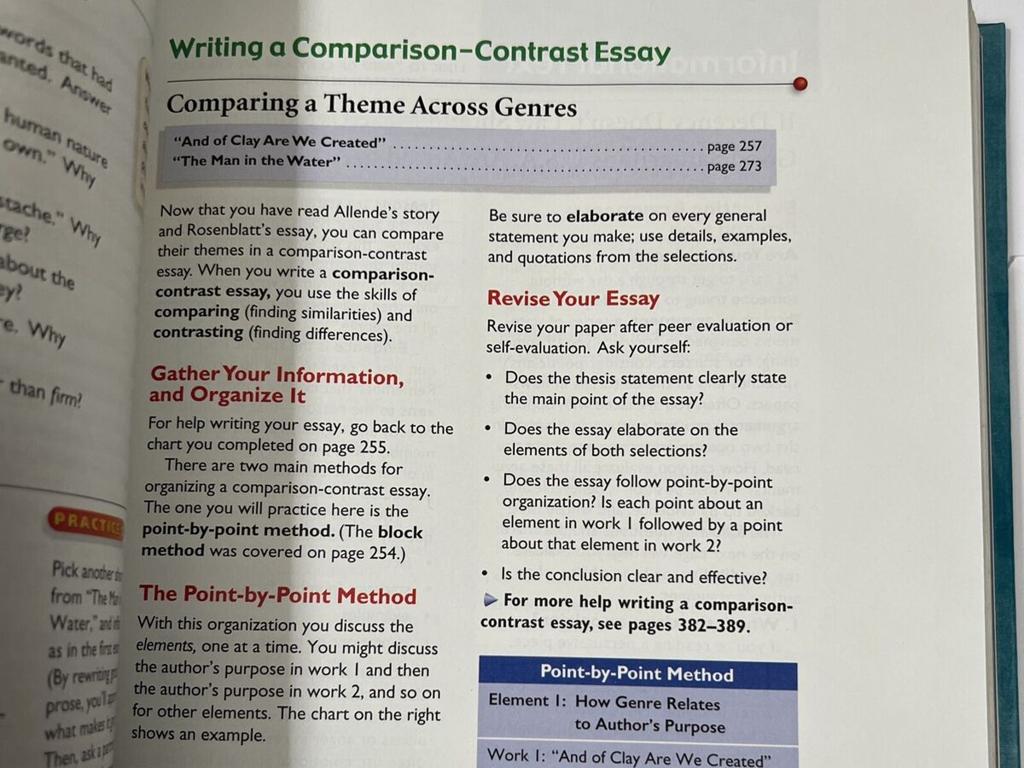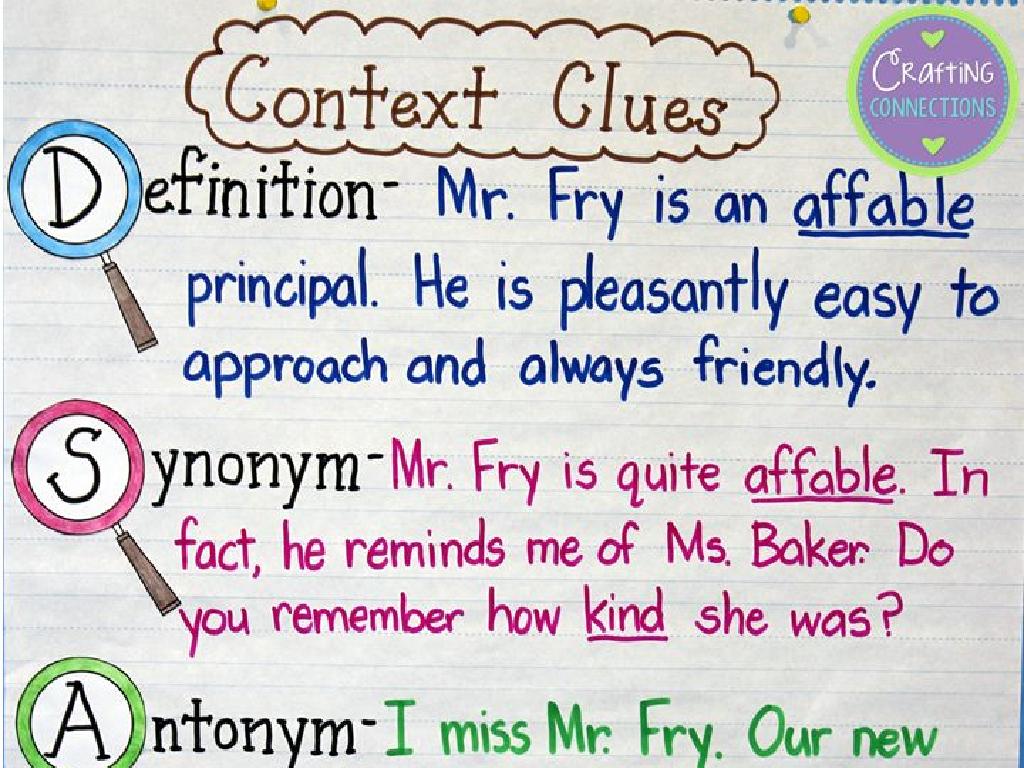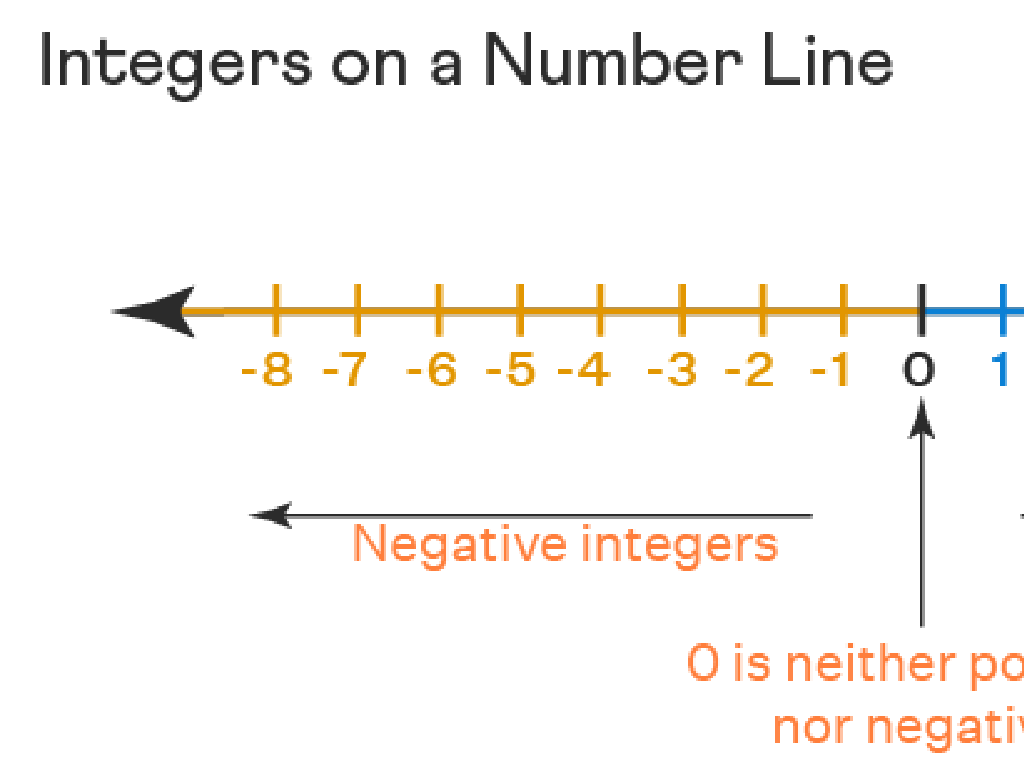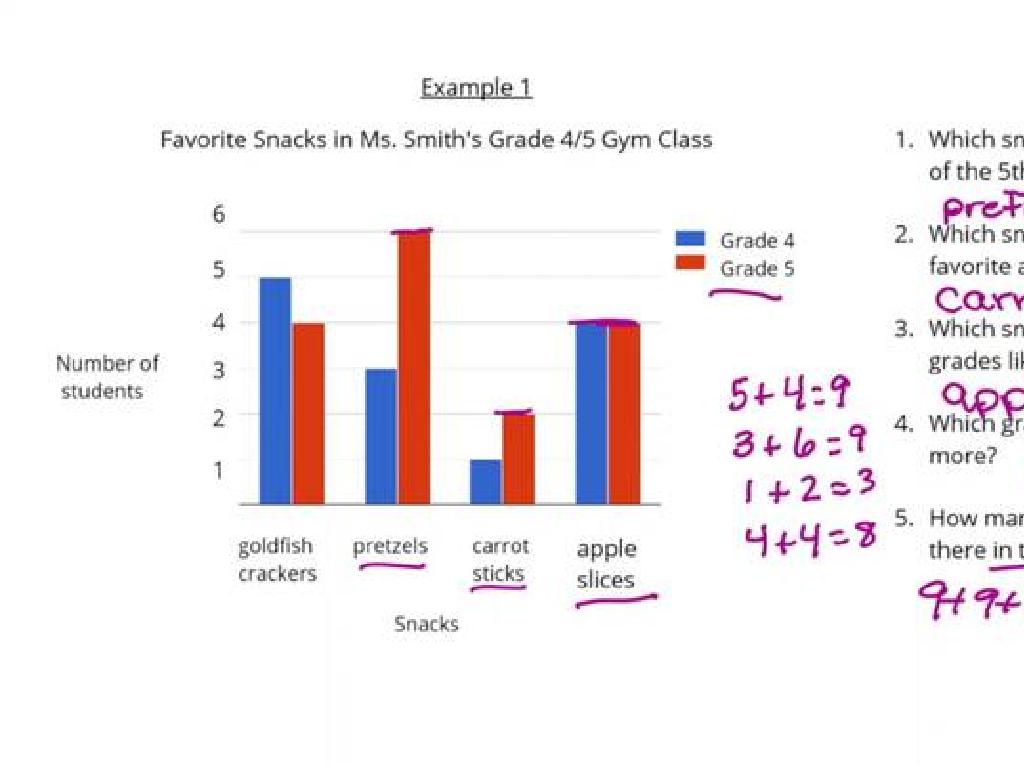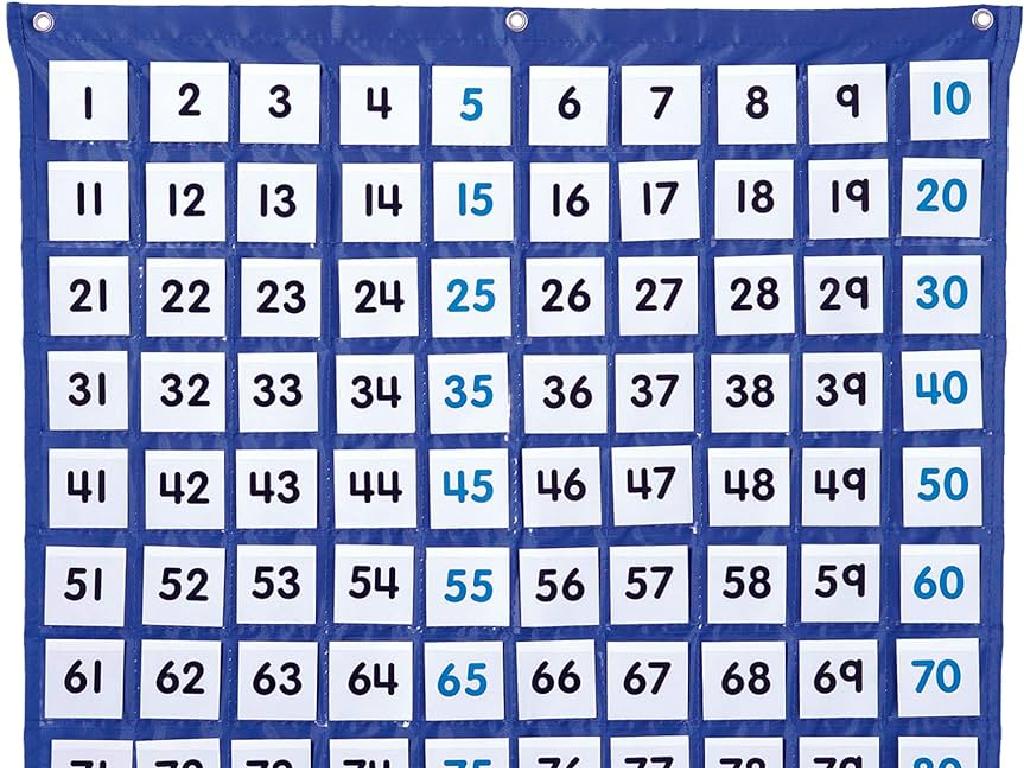Use Models To Add Two-Digit Numbers - With Regrouping
Subject: Math
Grade: First grade
Topic: Addition: Two Digits
Please LOG IN to download the presentation. Access is available to registered users only.
View More Content
Welcome to Addition: Adding Big Numbers!
– Learn to add two-digit numbers
– We’ll add numbers like 34 + 27 today
– Using models for easy understanding
– Think of blocks or drawings to represent numbers
– Adding means combining numbers
– Like putting together 2 apples and 3 apples to have 5 apples
– Find the total with regrouping
– Sometimes we get a number more than 9, and we carry over to the next ten
|
This slide introduces first graders to the concept of addition with two-digit numbers, emphasizing the use of models for better understanding. Begin by explaining that adding is like combining things together to see how many there are altogether. Use visual aids like blocks or drawings to represent the numbers being added. Show how to line up the numbers by place value and explain the process of regrouping when the sum exceeds 9 in any place value. Encourage students to practice with simple examples and praise their efforts to build confidence.
Understanding Regrouping in Addition
– Regrouping is magical in math!
– Move big numbers to the next spot
– If we add 9 + 7, we get 16. The 6 stays, but the 1 moves over to the tens place.
– Exchange ten ones for one ten
– Just like 10 pennies can be traded for 1 dime, in math we trade 10 ones for 1 ten.
– Practice regrouping with examples
– Let’s add 27 + 19. We regroup the ones to make a ten and add it to the tens place.
|
This slide introduces the concept of regrouping, a fundamental skill in addition when dealing with two-digit numbers. Regrouping is necessary when the sum of the ones place exceeds 9 and we need to carry over to the tens place. Use tangible examples like trading pennies for a dime to help students visualize the process. Provide several examples on the board and walk through them step by step, showing how to carry over the extra ten. Encourage students to use physical objects like blocks or coins to practice this concept. Prepare to have students work on simple addition problems that require regrouping and share their solutions.
Adding Two-Digit Numbers Without Regrouping
– Start with easy addition
– Add ones and tens separately
– Example: 23 + 15
– Add 3 (ones) + 5 (ones) = 8 (ones), and 2 (tens) + 1 (tens) = 3 (tens)
– No regrouping needed here
– Both sums are less than 10, so we write the numbers below each column
|
This slide introduces students to the concept of adding two-digit numbers without the need for regrouping. Start by explaining that when we add numbers, we add the ones (right column) and tens (left column) separately. Use the example 23 + 15 to show that 3 ones plus 5 ones equals 8 ones, and 2 tens plus 1 ten equals 3 tens. Emphasize that in this case, since both sums are less than 10, we can simply write the sums below their respective columns without having to carry over any numbers. This is a foundational skill that will prepare them for more complex addition with regrouping.
Understanding Regrouping in Addition
– Regroup when ones exceed 9
– Group ten ones into a ten
Like 10 ones blocks can be traded for 1 tens block
– Move the new ten to tens place
The tens block joins other tens in the next column
– Practice with examples
Use blocks or drawings to add 14 + 9
|
This slide introduces the concept of regrouping, a key skill in adding two-digit numbers. Regrouping is necessary when the sum of the ones place is greater than 9, and we need to carry over to the tens place. Use manipulatives like blocks or drawings to visually demonstrate this concept. For example, show that adding 14 and 9 requires regrouping because the ones column adds up to 13 (4 ones + 9 ones = 13 ones), which is more than 9. We then regroup the 10 ones as 1 ten and add it to the tens place. Provide several examples and encourage students to practice with hands-on materials. This will help them understand the process of regrouping and why it’s necessary.
Let’s Try Adding with Regrouping!
– Start with 27 + 18
– Count tens and ones
– We have 2 tens (20) and 7 ones in 27, and 1 ten (10) and 8 ones in 18.
– Regroup ones into tens
– 15 ones become 1 ten and 5 ones.
– Add tens and ones for the sum
– Now, 6 tens (60) and 5 ones make 65!
|
This slide introduces students to the concept of regrouping when adding two-digit numbers. Start by presenting the problem 27 + 18. Explain that we first add the ones (7 ones + 8 ones = 15 ones) and then the tens (2 tens + 1 ten = 3 tens). Since we cannot have more than 9 ones, we regroup 15 ones into 1 ten and 5 ones. Now we add the regrouped tens to the original tens (3 tens + 1 ten = 4 tens), but since we started with 5 tens (from 27 and 18), we actually have 6 tens. Finally, we combine the tens and ones to get the sum of 65. Use visual aids like blocks or drawings to help students understand the regrouping process. Practice with more examples if time allows.
Adding Two-Digit Numbers with Blocks
– Blocks represent ones
– Sticks of blocks are tens
– Build numbers using blocks and sticks
– If we have 23, we make 2 sticks and 3 blocks
– Practice adding with models
– Add 23 and 35 using blocks and sticks to see regrouping
|
This slide introduces the concept of using physical models, such as blocks and sticks, to help first graders visualize the process of adding two-digit numbers with regrouping. Each individual block represents a single unit (one), and a stick, which is a group of ten blocks, represents the tens place. By building numbers with these models, students can concretely see how numbers are composed and how addition works, especially when it comes to regrouping (carrying over to the next tens place). In the class activity, students will practice creating two-digit numbers with blocks and sticks and then physically combine them to add the numbers together, observing the regrouping process. The teacher should prepare several examples to demonstrate and then let students try their own, guiding them through the regrouping process as needed.
Practice Time: Adding with Blocks!
– Use blocks to add numbers
– Example: 34 + 27
– We have 3 tens (30) and 4 ones for 34, and 2 tens (20) and 7 ones for 27
– Arrange blocks in tens and ones
– Place your tens together and ones together
– Regroup if you have more than 10 ones
– If ones are 10 or more, make a new ten block
|
This slide is an interactive activity for students to practice addition with regrouping using physical blocks and sticks. Start by explaining that each block represents one unit and sticks represent tens. Show them how to separate the tens and ones for each number. For 34, they should have 3 sticks (tens) and 4 blocks (ones), and for 27, 2 sticks and 7 blocks. When they combine the ones, they will have more than 10, so they need to regroup and create another stick (ten). This hands-on activity helps them visualize the concept of regrouping in addition. Prepare to assist students who may have difficulty with regrouping and ensure that each student has enough blocks and sticks to perform the activity.
Class Activity: Adding with Friends
– Pair up and get blocks
– Receive two numbers to add
– Use blocks to add numbers
– Stack blocks for ones and tens
– Show and share your results
|
This activity is designed to help first graders understand the concept of addition with regrouping using a hands-on approach. Each pair of students will receive a set of blocks and two numbers. They will use the blocks to represent the ones and tens places of each number and physically combine them to see how regrouping works when the ones exceed ten. After adding, they will present their method and findings to the class, reinforcing their understanding through teaching. For the teacher: Prepare sets of blocks in advance, ensure each set has enough blocks for regrouping, and create a variety of two-digit addition problems. Walk around the classroom to assist and guide pairs as needed. Possible variations of the activity could include using different manipulatives, such as beads or coins, or having students draw their block representations on paper.
Adding Big Numbers with Models
– Fun with adding big numbers
– Regrouping with more than 9 ones
– When we reach 10 ones, we make a new ten.
– Using blocks to visualize addition
– Blocks represent ones and tens for easy counting.
– Practice makes perfect
– Let’s try adding 23 and 15 using blocks!
|
This slide is a review of the previous lesson where students learned to add two-digit numbers using models. Emphasize that math can be enjoyable, especially when using tangible objects like blocks to represent numbers. Explain regrouping as a method to simplify addition when the ones place exceeds 9, converting excess ones into tens. Use blocks or other visual aids to demonstrate how to combine numbers, reinforcing the concept of regrouping. Encourage students to practice with different numbers to gain confidence. For the next class, prepare several examples for students to work on, both individually and in groups, to solidify their understanding of regrouping in addition.
Homework Time: Adding with Models
– Take home your addition worksheet
– Use drawings or blocks for help
– Draw or stack blocks to visualize the numbers
– Add two-digit numbers with regrouping
– Remember to carry over if a column adds up to 10 or more
– Bring back completed sheet for a reward
|
This homework assignment is designed to reinforce the concept of adding two-digit numbers with regrouping, which was taught in class. Encourage students to use visual aids like drawings or physical blocks to help them understand the process of regrouping. Remind them that when one column adds up to 10 or more, they need to ‘carry the one’ to the next column. This hands-on activity will help solidify their understanding of addition with regrouping. Offer a sticker as a small incentive to motivate them to complete and return the worksheet. Be prepared to review any challenging problems the next day and celebrate their efforts.

